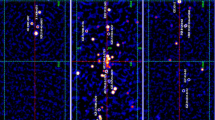Abstract
Three-dimensional numerical hydrodynamical modeling of a radiative wind and accretion disk in a close binary system with a compact object is carried out, using the massive X-ray binary LMC X-3 as an example. This system contains a precessing disk, and may have relativistic jets. These computations show that an accretion disk with a radius of about 0.20 (in units of the component separation) forms from the radiative wind from the donor when the action of the wind on the central source is taken into account, when the accretion rate is equal to the observed value (about 3.0 × 10−8 M ⊙/year, which corresponds to the case when the donor overflows its Roche lobe by nearly 1%). It is assumed that the speed of the donor wind at infinity is about 2200 km/s. The disk that forms is geometrically thick and nearly cylindrical in shape, with a low-density tunnel at its center extending from the accretor through the disk along the rotational axis. We have also modeled a flare in the disk due to short-term variations in the supply of material through the Lagrange point L1, whose brightnesses and durations are able to explain flares in cataclysmic variables and X-ray binaries. The accretion disk is not formed when the donor underfills its Roche lobe by 0.5%, which corresponds to an accretion rate onto the compact object of 2.0 × 10−9 M ⊙/year. In place of a disk, an accretion envelope with a radius of about 0.03 forms, within which gas moves along very steep spiral trajectories before falling onto the compact object. As in the accretion-disk case, a tunnel forms along the rotational axis of the accretion envelope; a shock forms behind the accretor, where flares occur in a compact region a small distance from the accretor at a rate of about six flares per orbital period, with amplitudes of about 10m or more. The flare durations are two to four minutes, and the energies of individual particles at the flare maximum are about 100–150 keV. These flares appear to be analogous to the flares observed in gamma-ray and X-ray burst sources. We accordingly propose a model in which these phenomena are associated with massive, close X-ray binary systems with component-mass ratios exceeding unity, in which the donor does not fill its Roche lobe. Although no accretion disk forms around the compact object, an accretion region develops near the accretor, where the gamma-ray and X-ray flares occur.
Similar content being viewed by others
References
V. V. Nazarenko, Mon. Not. R. Astron. Soc. (in press).
V. V. Nazarenko, Astron. Rep. 50, 647 (2006).
S. H. Lubow and F. H. Shu, Astrophys. J. 198, 383 (1975).
R. A. M. J. Wijers and J. E. Pringle, Mon. Not. R. Astron. Soc. 308, 207 (1999).
V. V. Nazarenko and L. V. Glazunova, Astron. Rep. 49, 826 (2005).
R. L. Kurucz, Astrophys. J., Suppl. Ser. 40, 1 (1979).
O. M. Belotserkovskii and Yu. M. Davydov, Method of Large Particles in Gas Dynamics (Nauka, Moscow, 1982), p. 391 [in Russian].
D. P. Cox and E. Daltabuilt, Astrophys. J. 167, 113 (1971).
V. V. Nazarenko, L. V. Glazunova, and L. S. Shakun, Astron. Zh. 82, 319 (2005) [Astron. Rep. 49, 284 (2005)].
V. V. Nazarenko, L. V. Glazunova, and S. V. Nazarenko, Astron. Rep. 49, 814 (2005).
J. D. Castor, D. C. Abbott, and R. I. Klein, Astrophys. J. 195, 157 (1975).
D. Steeghs, K. Horne, T. N. March, and J. F. Donati, Mon. Not. R. Astron. Soc. 281, 626 (1996).
D. Steeghs, E. T. Harlaftis, and K. Horne, Mon. Not. R. Astron. Soc. 290, L28 (1997).
D. Steeghs, E. T. Harlaftis, and K. Horne, Mon. Not. R. Astron. Soc. 296, 463 (1998).
E. T. Harlaftis, D. Steeghs, K. Horne, et al., Mon. Not. R. Astron. Soc. 306, 348 (1999).
L. Morales-Rueda, T. March, and I. Biliington, Mon. Not. R. Astron. Soc. 313, 454 (2000).
M. J. Rees and P. Meszaros, Astrophys. J. 430, L93 (1994).
M. Livio and B. Warner, Observatory 104, 152 (1984).
Author information
Authors and Affiliations
Additional information
Original Russian Text © V.V. Nazarenko, 2008, published in Astronomicheskiĭ Zhurnal, 2008, Vol. 85, No. 1, pp. 46–59.
Rights and permissions
About this article
Cite this article
Nazarenko, V.V. Formation of a radiative wind and accretion disk in microquasars. Generation of flare activity in the disk due to an increase in the supply of material to the Lagrange point L1. The system LMC X-3. Astron. Rep. 52, 40–52 (2008). https://doi.org/10.1134/S1063772908010058
Received:
Accepted:
Published:
Issue Date:
DOI: https://doi.org/10.1134/S1063772908010058




